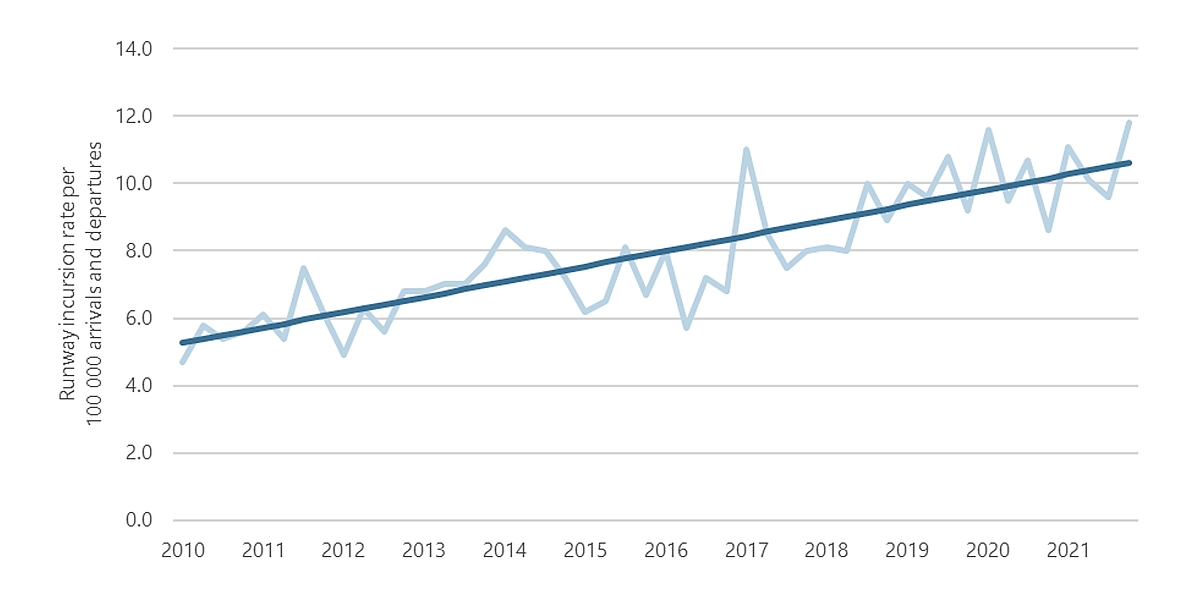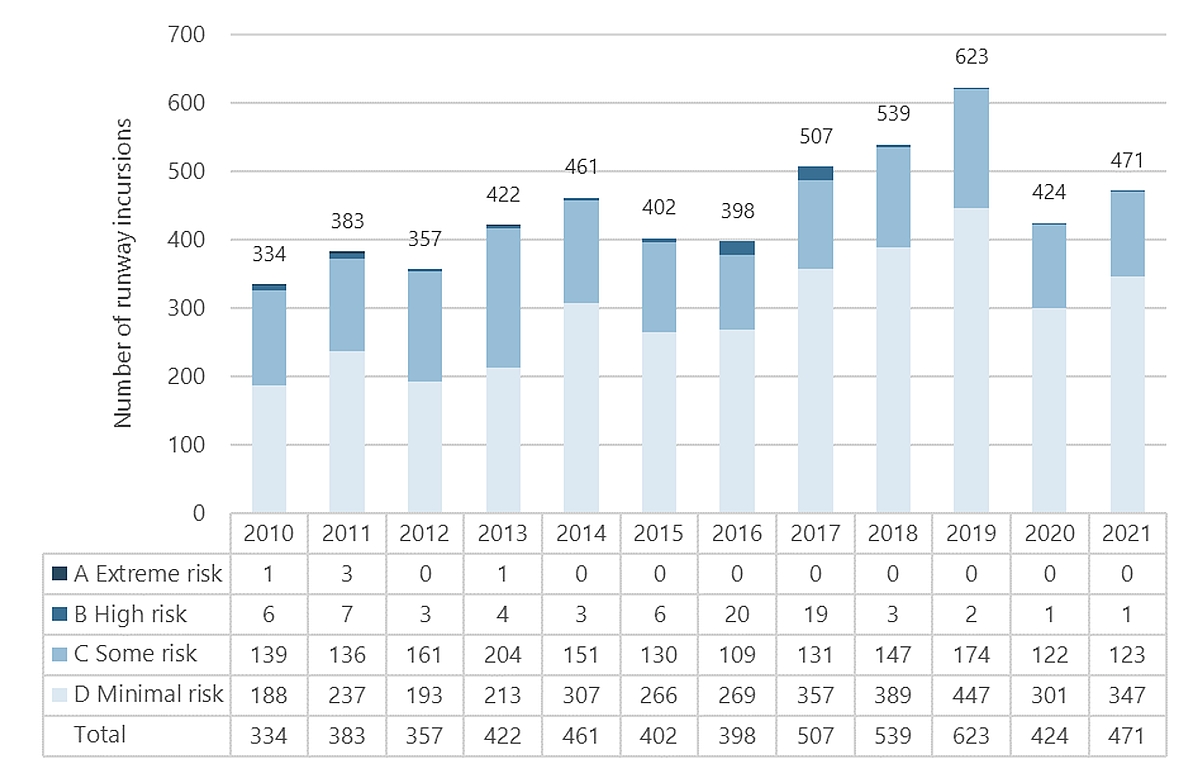Risk of collisions from runway incursions
Runway incursions lead to an ongoing risk of aircraft colliding with vehicles or other aircraft.
Transcript
Did you know that the rate of runway incursions in Canada has more than doubled since 2010? This is when an aircraft or vehicle incorrectly enters an active runway.
Although only a small number of incursions were classified as high risk, the consequences of a collision could be catastrophic, and remains a global concern.
In 2021, NAV CANADA recorded 471 runway incursions.
Although there have not been any recent collisions resulting from incursions, the TSB is concerned about the potential risks, and is calling on the regulator, air traffic service providers, operators and airports to implement effective ways to reduce incursions.
Until there is a sustained reduction in the number of runway incursions or effective defences are implemented in high-risk locations, this issue will remain on the Watchlist.
Learn more about Watchlist 2022 at tsb.gc.ca/Watchlist
The situation
Every year, there are millions of successful takeoffs and landings on Canadian runways. However, an accident can occur when an aircraft or vehicle incurs upon a runway that is in use.
Collectively, the aviation industry has made gradual, incremental changes to address this risk. Individual operators, airports, and air traffic services (ATS) providers have adapted procedures, added new visual cues, or improved surveillance. However, despite these improvements, the overall rate of runway incursions continues to increase.
The runway incursion rate in Canada has risen from an average rate of 5.3 incursions per 100 000 arrivals and departures in 2010 to an average of 10.7 in 2021.Footnote 1 The rate of incursions has doubled in twelve years (corresponding to an annualized increase of 5.9% per year).
Figure 1. Data table
| Year | Quarter | Rate | Sen's Estimate |
|---|---|---|---|
| 2010 | Q1 | 4.7 | 5.264204545 |
| Q2 | 5.8 | 5.377967172 | |
| Q3 | 5.4 | 5.491729798 | |
| Q4 | 5.6 | 5.605492424 | |
| 2011 | Q1 | 6.1 | 5.719255051 |
| Q2 | 5.4 | 5.833017677 | |
| Q3 | 7.5 | 5.946780303 | |
| Q4 | 6.2 | 6.060542929 | |
| 2012 | Q1 | 4.9 | 6.174305556 |
| Q2 | 6.3 | 6.288068182 | |
| Q3 | 5.6 | 6.401830808 | |
| Q4 | 6.8 | 6.515593434 | |
| 2013 | Q1 | 6.8 | 6.629356061 |
| Q2 | 7.0 | 6.743118687 | |
| Q3 | 7.0 | 6.856881313 | |
| Q4 | 7.6 | 6.970643939 | |
| 2014 | Q1 | 8.6 | 7.084406566 |
| Q2 | 8.1 | 7.198169192 | |
| Q3 | 8.0 | 7.311931818 | |
| Q4 | 7.2 | 7.425694444 | |
| 2015 | Q1 | 6.2 | 7.539457071 |
| Q2 | 6.5 | 7.653219697 | |
| Q3 | 8.1 | 7.766982323 | |
| Q4 | 6.7 | 7.880744949 | |
| 2016 | Q1 | 8.0 | 7.994507576 |
| Q2 | 5.7 | 8.108270202 | |
| Q3 | 7.2 | 8.222032828 | |
| Q4 | 6.8 | 8.335795455 | |
| 2017 | Q1 | 11.0 | 8.449558081 |
| Q2 | 8.5 | 8.563320707 | |
| Q3 | 7.5 | 8.677083333 | |
| Q4 | 8.0 | 8.79084596 | |
| 2018 | Q1 | 8.1 | 8.904608586 |
| Q2 | 8.0 | 9.018371212 | |
| Q3 | 10.0 | 9.132133838 | |
| Q4 | 8.9 | 9.245896465 | |
| 2019 | Q1 | 10.0 | 9.359659091 |
| Q2 | 9.6 | 9.473421717 | |
| Q3 | 10.8 | 9.587184343 | |
| Q4 | 9.2 | 9.70094697 | |
| 2020 | Q1 | 11.6 | 9.814709596 |
| Q2 | 9.5 | 9.928472222 | |
| Q3 | 10.7 | 10.04223485 | |
| Q4 | 8.6 | 10.15599747 | |
| 2021 | Q1 | 11.1 | 10.2697601 |
| Q2 | 10.1 | 10.38352273 | |
| Q3 | 9.6 | 10.49728535 | |
| Q4 | 11.8 | 10.61104798 |
Number of occurrences in Canada
NAV CANADA recorded 471 runway incursions in Canada in 2021. Although only a small number of incursions were classified as high risk, the consequences of a collision could be catastrophic given the potential for injury or loss of life from a single accident.
Figure 2. Data table
| 2010 | 2011 | 2012 | 2013 | 2014 | 2015 | 2016 | 2017 | 2018 | 2019 | 2020 | 2021 | |
|---|---|---|---|---|---|---|---|---|---|---|---|---|
| Extreme risk | 1 | 3 | 0 | 1 | 0 | 0 | 0 | 0 | 0 | 0 | 0 | 0 |
| High risk | 6 | 7 | 3 | 4 | 3 | 6 | 20 | 19 | 3 | 2 | 1 | 1 |
| Some risk | 139 | 136 | 161 | 204 | 151 | 130 | 109 | 131 | 147 | 174 | 122 | 123 |
| Minimal risk | 188 | 237 | 193 | 213 | 307 | 266 | 269 | 357 | 389 | 447 | 301 | 347 |
| Total | 334 | 383 | 357 | 422 | 461 | 402 | 398 | 507 | 539 | 623 | 424 | 471 |
The Transportation Safety Board of Canada (TSB) has been concerned by runway incursions for many years. In 2009, the Board issued 3 safety concerns related to runway incursions following an investigation into a 2007 incident at Toronto Pearson International Airport (CYYZ).Footnote 2 Since this issue was added to the Watchlist in 2010, the TSB has completed 15 investigationsFootnote 3 into runway incursions. In 2019, following a safety issue investigation that focused on 2 closely spaced parallel runways known as the “south complex” at CYYZ, the Board made 4 recommendations intended to address some of the risks related to incursions.Footnote 4
The risks to people, property, and the environment
Although there has not been a recent collision as a result of a runway incursion in Canada, the potential consequences of such a collision could be catastrophic. Therefore, the Board is concerned that the rate of runway incursions in Canada and the associated risks of collision will remain elevated until effective defences created to address identified hazards are implemented at airports and in aircraft, vehicles, and ATS facilities across Canada.
A global concern
Runway incursions are a global concern. The International Civil Aviation Organization’s (ICAO’s) 2017 Global Runway Safety Action Plan noted that “although the [number of] runway incursion accidents reported between the period of 2008 to 2016 is very low, the number of runway incursion incidents remains high.”Footnote 5
Action taken
Issues on the Watchlist are complex and difficult to solve, requiring action from many stakeholders, including operators and the regulator. Although some steps may have been taken, more needs to be done. These are some of the steps that have been taken to date.
There is no one solution that will reduce runway incursions on its own. Reducing the risk of runway incursions is a complex issue and requires collaboration from all sectors of the aviation industry and tailored solutions for each airport.
The Transport Canada and NAV CANADA–led Runway Safety Action Team Sub-Committee on Runway Incursions (RSAT-SC), with membership from affected airports and airlines, was formed in 2020 to collaboratively look at opportunities to reduce the number of runway incursions.
Across Canada, in-cockpit aids to increase flight crews’ situational awareness, such as electronic flight bags with moving maps, are becoming more prevalent with operators. NAV CANADA has amended radio communications protocols so that instructions are better understood and followed. And locally, some airport authorities are implementing design changes, such as angled holding positions, to increase flight crews’ situational awareness.
However, despite these actions, there continues to be a consistent increase in the overall rate of runway incursions at Canadian airports.
Action required
Reducing the risk of runway incursions is a complex issue and requires collaboration from all sectors of the air transportation industry. There is no single solution that will reduce the risk of runway incursions nationwide. Rather, solutions tailored for each airport, in combination with wider-reaching technological advancements such as in-cockpit situational awareness aids and runway status lights, may be more effective.
This issue will remain on the TSB Watchlist until:
- effective defences to prevent runway incursions are implemented in incursion hotspots; or
- the rate of runway incursions demonstrates a sustained reduction, and the number of high-risk incursions continues to show a sustained reduction.


